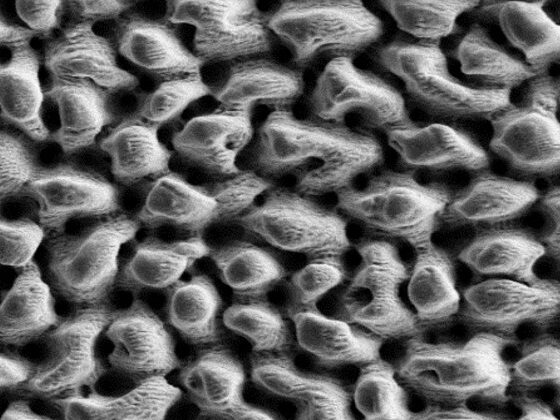Marking of different materials such as metals, plastics and glasses
Great contrast thanks to black marking with USP lasers
Combination with other processes such as drilling or functionalization
Contrasting markings
Laser marking is a non-contact marking process in which a small amount of material is removed from the surface of the component. In the course of the steadily improved quality management, labels such as the serial and batch number, the place of manufacture, the production line and any other information are marked directly on the component in order to clearly trace the manufactured component. Such labels are often applied directly in the assembly line in order to be able to maintain high productivity. Through targeted product labeling, the manufacturer’s information can be implemented as soon as the product is finished and made available for later times. In the event of a problem, this type of identification can be used to identify the place of manufacture, the time of manufacture or the machine responsible, so that an entire batch can be identified as necessary.
Marking of metallic materials
A prerequisite for good readability is a permanent high contrast between the applied marking and the surrounding material. When USP processing of metallic materials, hierarchical structures in the micrometer range are created through a self-arrangement effect, which are superimposed by nanostructures. These so-called cone-like protrusions (CLP) have undercuts in addition to a surface that is five to ten times as large. A high level of light absorption is characteristic of this functionalized surface. The incident light is refracted so diffusely on the microstructures produced that there is no back reflection. As a result, the functional surface appears black. The use of a laser system enables the structures to be applied over a large area or fine machining of selective material areas.
High variety of materials
In contrast, there are other materials, such as tungsten carbide, ceramics or green compacts, in which an extremely smooth and homogeneous engraving can produce a clearly legible, detectable mark. The labeling bases are very even and even, the labeling is only a few micrometers deep (<10 micrometers already sufficient). Ultrashort pulse laser marking is also possible on plastics. In the case of multi-coated or lacquered plastics, a contrast is created by removing / evaporating the top layers. In the case of lighter plastics, laser processing changes the color of the plastic by briefly melting it and appears dark on the light-colored plastic substrate. The labeling of plastics is very interesting and indispensable, especially for medical technology. The smooth plastic surface is not changed either in the lettering or in the surrounding material and germs can still not adhere to the material.
Applications
Product labels are often only available in a limited space and should inconspicuously contain all important information. The USP laser is ideal for fine, micrometer-accurate marking. The component and the surrounding area of the lettering are not influenced by the machining process due to the almost non-existent thermal load. Structure resolutions in the (sub) micrometer range can be produced and burr-free engraving is possible.
- Common labels such as barcodes, data matrix codes, QR codes, any sequence of letters, symbols or logos
- Labeling of plastics in medical technology (pumps, tubes, stents and other components)
PULSAR PHOTONICS COVERS THE COMPLETE PROCESS CHAIN

Your Personal Contact person
Dr. Marius Gipperich
Technical Sales


